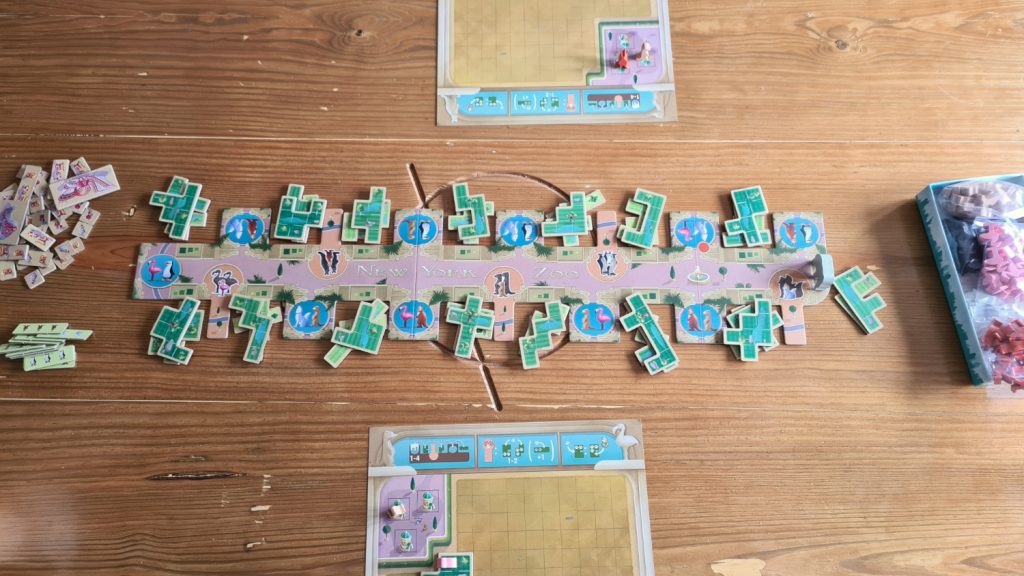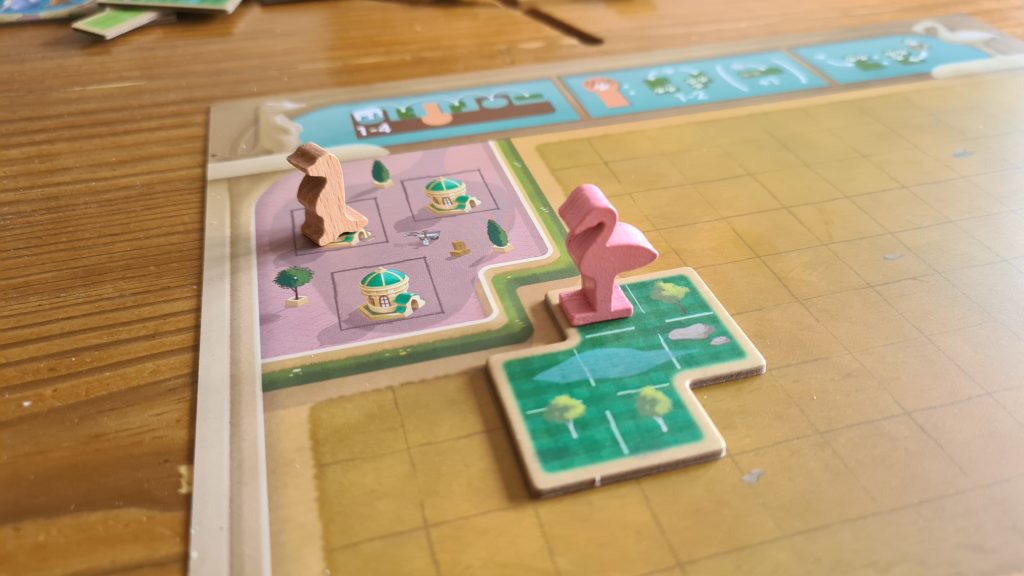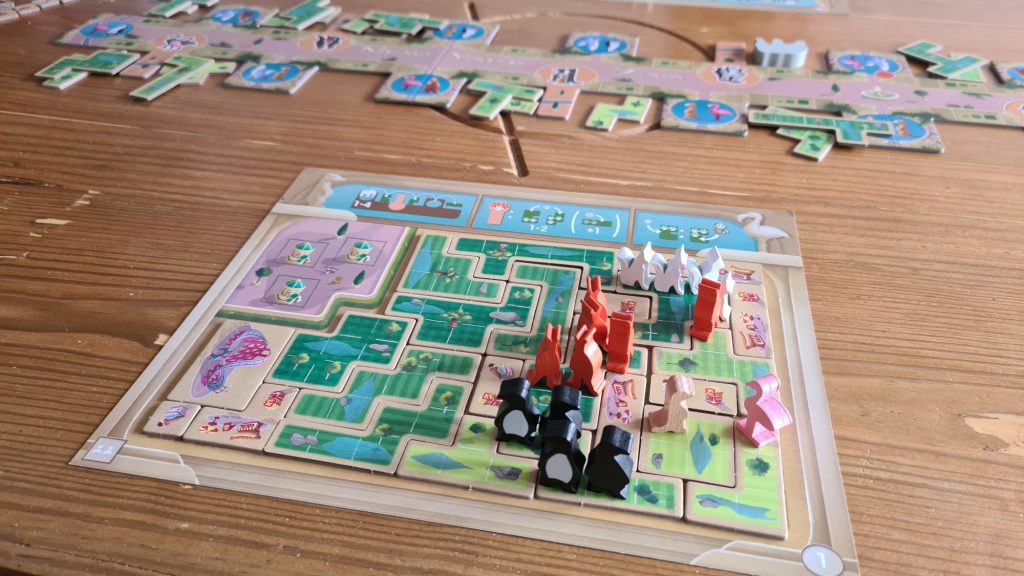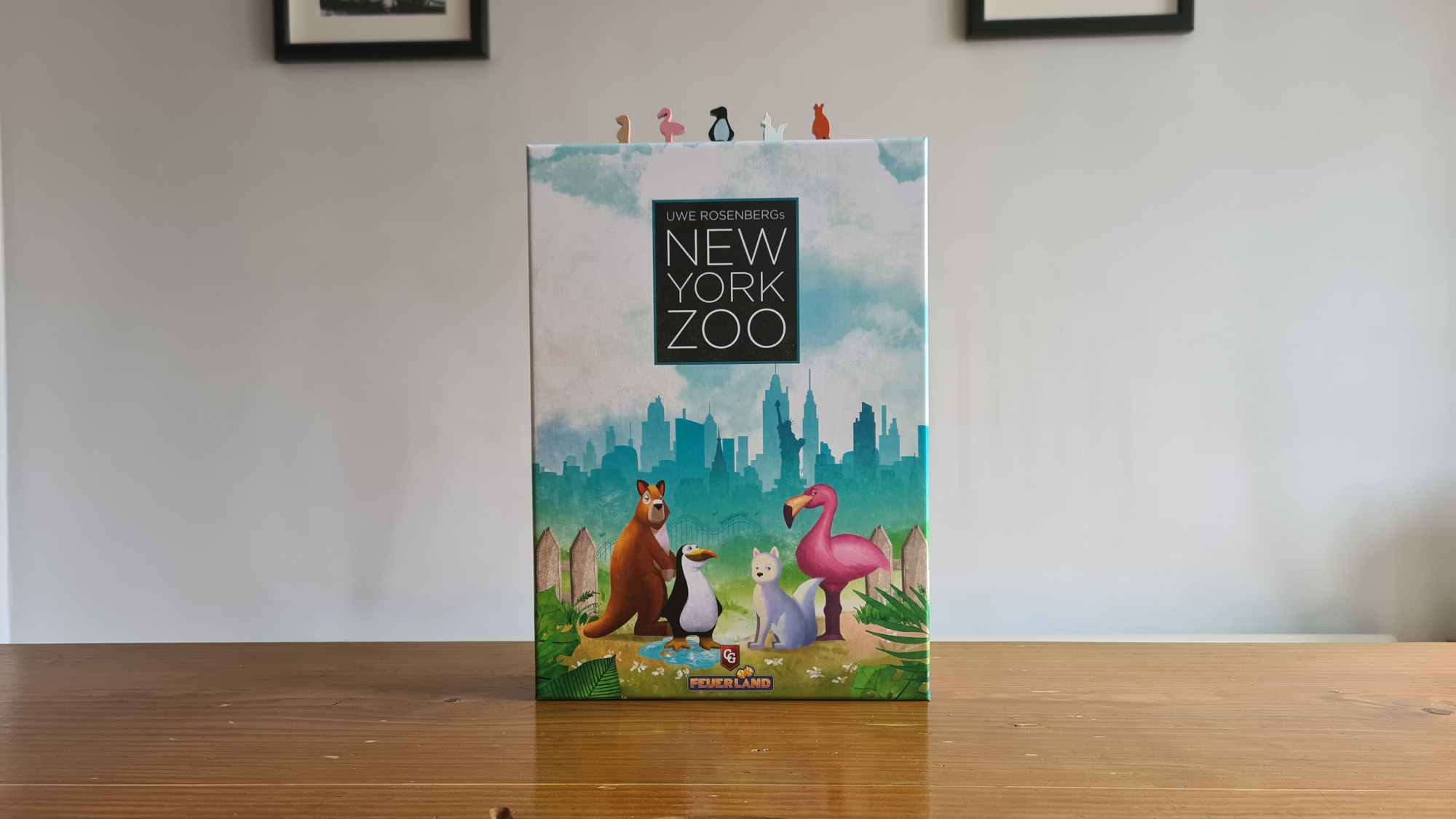New York Zoo is a polyomino tile placement board game, from publisher Feuerland Spiele. Designed by Uwe Rosenberg, featuring artwork from Felix Wermke, the game sees 1 – 5 players placing animal enclosures and attractions into their zoo, and breeding the likes of penguins and kangaroos. Lasting around 45 minutes the game uses a rondel to drive the race of completing your zoo. However, does this mean you just go round and round without getting anywhere? Let’s find out!
With the central board placed in the middle of the table, enclosure tiles are added to the gaps. Three tiles of differing sizes are added into the gaps, randomising the available tiles. Depending on the player count, players take their zoo player boards, with two starting animal meeples gained. The boards must be given out correctly in turn order as the number of spaces to fill is there to balance out the advantage of going earlier in the turn order. Finally, the elephant meeple is added to the rondel track and the game is ready to play.
On a player’s turn they will move the elephant meeple clockwise around the rondel, up to 4 spaces in a 2/4 player game and up to 3 spaces in a 3/5 player game. Choosing to land on a pile of enclosure tiles sees the top tile taken, whilst landing on an animal acquisition space sees the two depicted animal meeples claimed. When taking an enclosure tile it must instantly be added to your zoo board. Tiles do not have to be placed adjacent to previous tiles, though players are aiming to fully fill the board – so leaving gaps isn’t ideal. When a tile is placed the player must move 1 – 2 animals into the enclosure – either from their animal houses (effectively storage) or from other enclosures – though this cannot leave an enclosure empty.

When a player gains animal meeples they can be placed into an enclosure of matching animal type or into an empty animal house. Making this a little more complicated, whenever a player adds an animal in this way to an enclosure they can also move a matching animal from a house into the same enclosure. This can be slightly forgettable in your first game, so players may have to keep reminding each other.
If at this point any player has a full enclosure – with an animal meeple on each space – they trade them in. Moving one meeple back to their housing, if they wish, the player discards the meeples from the enclosure. Doing this awards the player an attraction tile, which come in a variety of shapes and sizes. These plug the gaps between enclosures, helping players towards a full zoo.
Not counting as a space on the rondel are breeding borders. Going past these triggers something for all players, not just the active player. Depending on the animal depicted players can breed in up to two enclosures of that specific animal type. This sees an enclosure with two or more of the depicted animal type gaining a single additional animal meeple – potentially triggering the attraction tile bonus. There is also another easily forgettable rule for 1 – 3 players for bonus breeding. There is iconography on the board to try to remind you but first time players still needed a slight nudge. Effectively, if a player breeds one type of animal they can then breed in an enclosure of any animal type. This speeds things up slightly for lower player counts, with more players pushing the rondel faster.

The aim of New York Zoo is not to score points, nor is it to breed animals. The winner is simply the first player to completely fill their zoo board with tiles. Of course players are dragged one way and another by the options and possibilities. One minute players will be focused on the end goal of filling their board and all of a sudden they will be distracted by breeding animals, thanks to the bonuses.
It matters what others do on their turns, at least some of the time. When breeding occurs on someone else’s turn there is almost an excitement, derived from someone else triggering that for you rather than the other way around. The rest of the game feels very much like a multiplayer solitaire experience. The other players can take tiles you want and will move the elephant around the rondel but otherwise it’s all about the puzzle in front of you.
The first half of New York Zoo feels rather nonchalant and pleasant. Players are slowly building out their park, squeezing in enclosures, gaining a range of animal meeples and plugging gaps with attractions. Then, players start to realise that eventually their choices can come back to haunt them. Until players reach this point the park space is so large that inevitably any placed tile can be worked around later. When it gets down to half the size then every placement seems to matter so much more. Not only is the space to work in limited, the number of tiles is also massively reduced.

Always playing with the 2 player variant rules, of starting with a random range of enclosure tiles already in place, can get around this. It means that the game length is cut and gets things to the business end of the experience quicker. It’s not entirely a negative though. For brand new players, it means that in the first half of the game tile placements are not likely to screw you over long term – giving players a chance to play while learning.
The colours of tiles are all shades of green and this seems like a huge oversight. The shades are close enough for those without any colour blindness to mistake them, let alone even mild sufferers. In real life animals need different enclosure types and they aren’t all green grass. There could easily have been four different terrain types such as rock, grass, sand and forest that utilize different colours and could have been distinctive. This would have made setting up infinitely easier and added some more variety to the players’ zoos. It is far from all bad on the production front though, with epic animal meeples, adding a touch of eye-catching cuteness to the title.
Building out your zoo slowly but surely, players can visually see their progress and often the games end close between all involved. However, filling an entire tile full of animal meeples only to trade them all in for a small attraction tile feels somewhat lacklustre. There is the small success of an attraction tile filling in a gap but certainly for the larger enclosures it’s a bit like “is that it?”. Combine this with the few forgettable non-streamlined rules and it makes New York Zoo only a solid game. It will grab players with the animal meeples and zoo theme but unfortunately does little else to inspire a lot of repeat plays.
(Editor’s Note: New York Zoo was provided to us by Asmodee for the review. The game is currently available from local board game stores! Find your local store here.)

